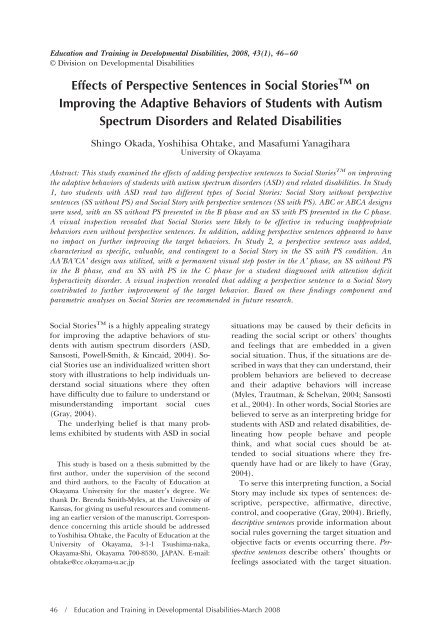Download the Journal (PDF) - Division on Autism and ...
Download the Journal (PDF) - Division on Autism and ...
Download the Journal (PDF) - Division on Autism and ...
Create successful ePaper yourself
Turn your PDF publications into a flip-book with our unique Google optimized e-Paper software.
Educati<strong>on</strong> <strong>and</strong> Training in Developmental Disabilities, 2008, 43(1), 46–60<br />
© <str<strong>on</strong>g>Divisi<strong>on</strong></str<strong>on</strong>g> <strong>on</strong> Developmental Disabilities<br />
Effects of Perspective Sentences in Social Stories TM <strong>on</strong><br />
Improving <str<strong>on</strong>g>the</str<strong>on</strong>g> Adaptive Behaviors of Students with <strong>Autism</strong><br />
Spectrum Disorders <strong>and</strong> Related Disabilities<br />
Shingo Okada, Yoshihisa Ohtake, <strong>and</strong> Masafumi Yanagihara<br />
University of Okayama<br />
Abstract: This study examined <str<strong>on</strong>g>the</str<strong>on</strong>g> effects of adding perspective sentences to Social Stories TM <strong>on</strong> improving<br />
<str<strong>on</strong>g>the</str<strong>on</strong>g> adaptive behaviors of students with autism spectrum disorders (ASD) <strong>and</strong> related disabilities. In Study<br />
1, two students with ASD read two different types of Social Stories: Social Story without perspective<br />
sentences (SS without PS) <strong>and</strong> Social Story with perspective sentences (SS with PS). ABC or ABCA designs<br />
were used, with an SS without PS presented in <str<strong>on</strong>g>the</str<strong>on</strong>g> B phase <strong>and</strong> an SS with PS presented in <str<strong>on</strong>g>the</str<strong>on</strong>g> C phase.<br />
A visual inspecti<strong>on</strong> revealed that Social Stories were likely to be effective in reducing inappropriate<br />
behaviors even without perspective sentences. In additi<strong>on</strong>, adding perspective sentences appeared to have<br />
no impact <strong>on</strong> fur<str<strong>on</strong>g>the</str<strong>on</strong>g>r improving <str<strong>on</strong>g>the</str<strong>on</strong>g> target behaviors. In Study 2, a perspective sentence was added,<br />
characterized as specific, valuable, <strong>and</strong> c<strong>on</strong>tingent to a Social Story in <str<strong>on</strong>g>the</str<strong>on</strong>g> SS with PS c<strong>on</strong>diti<strong>on</strong>. An<br />
AA’BA’CA’ design was utilized, with a permanent visual step poster in <str<strong>on</strong>g>the</str<strong>on</strong>g> A’ phase, an SS without PS<br />
in <str<strong>on</strong>g>the</str<strong>on</strong>g> B phase, <strong>and</strong> an SS with PS in <str<strong>on</strong>g>the</str<strong>on</strong>g> C phase for a student diagnosed with attenti<strong>on</strong> deficit<br />
hyperactivity disorder. A visual inspecti<strong>on</strong> revealed that adding a perspective sentence to a Social Story<br />
c<strong>on</strong>tributed to fur<str<strong>on</strong>g>the</str<strong>on</strong>g>r improvement of <str<strong>on</strong>g>the</str<strong>on</strong>g> target behavior. Based <strong>on</strong> <str<strong>on</strong>g>the</str<strong>on</strong>g>se findings comp<strong>on</strong>ent <strong>and</strong><br />
parametric analyses <strong>on</strong> Social Stories are recommended in future research.<br />
Social Stories TM is a highly appealing strategy<br />
for improving <str<strong>on</strong>g>the</str<strong>on</strong>g> adaptive behaviors of students<br />
with autism spectrum disorders (ASD,<br />
Sansosti, Powell-Smith, & Kincaid, 2004). Social<br />
Stories use an individualized written short<br />
story with illustrati<strong>on</strong>s to help individuals underst<strong>and</strong><br />
social situati<strong>on</strong>s where <str<strong>on</strong>g>the</str<strong>on</strong>g>y often<br />
have difficulty due to failure to underst<strong>and</strong> or<br />
misunderst<strong>and</strong>ing important social cues<br />
(Gray, 2004).<br />
The underlying belief is that many problems<br />
exhibited by students with ASD in social<br />
This study is based <strong>on</strong> a <str<strong>on</strong>g>the</str<strong>on</strong>g>sis submitted by <str<strong>on</strong>g>the</str<strong>on</strong>g><br />
first author, under <str<strong>on</strong>g>the</str<strong>on</strong>g> supervisi<strong>on</strong> of <str<strong>on</strong>g>the</str<strong>on</strong>g> sec<strong>on</strong>d<br />
<strong>and</strong> third authors, to <str<strong>on</strong>g>the</str<strong>on</strong>g> Faculty of Educati<strong>on</strong> at<br />
Okayama University for <str<strong>on</strong>g>the</str<strong>on</strong>g> master’s degree. We<br />
thank Dr. Brenda Smith-Myles, at <str<strong>on</strong>g>the</str<strong>on</strong>g> University of<br />
Kansas, for giving us useful resources <strong>and</strong> commenting<br />
an earlier versi<strong>on</strong> of <str<strong>on</strong>g>the</str<strong>on</strong>g> manuscript. Corresp<strong>on</strong>dence<br />
c<strong>on</strong>cerning this article should be addressed<br />
to Yoshihisa Ohtake, <str<strong>on</strong>g>the</str<strong>on</strong>g> Faculty of Educati<strong>on</strong> at <str<strong>on</strong>g>the</str<strong>on</strong>g><br />
University of Okayama, 3-1-1 Tsushima-naka,<br />
Okayama-Shi, Okayama 700-8530, JAPAN. E-mail:<br />
ohtake@cc.okayama-u.ac.jp<br />
46 / Educati<strong>on</strong> <strong>and</strong> Training in Developmental Disabilities-March 2008<br />
situati<strong>on</strong>s may be caused by <str<strong>on</strong>g>the</str<strong>on</strong>g>ir deficits in<br />
reading <str<strong>on</strong>g>the</str<strong>on</strong>g> social script or o<str<strong>on</strong>g>the</str<strong>on</strong>g>rs’ thoughts<br />
<strong>and</strong> feelings that are embedded in a given<br />
social situati<strong>on</strong>. Thus, if <str<strong>on</strong>g>the</str<strong>on</strong>g> situati<strong>on</strong>s are described<br />
in ways that <str<strong>on</strong>g>the</str<strong>on</strong>g>y can underst<strong>and</strong>, <str<strong>on</strong>g>the</str<strong>on</strong>g>ir<br />
problem behaviors are believed to decrease<br />
<strong>and</strong> <str<strong>on</strong>g>the</str<strong>on</strong>g>ir adaptive behaviors will increase<br />
(Myles, Trautman, & Schelvan, 2004; Sansosti<br />
et al., 2004). In o<str<strong>on</strong>g>the</str<strong>on</strong>g>r words, Social Stories are<br />
believed to serve as an interpreting bridge for<br />
students with ASD <strong>and</strong> related disabilities, delineating<br />
how people behave <strong>and</strong> people<br />
think, <strong>and</strong> what social cues should be attended<br />
to social situati<strong>on</strong>s where <str<strong>on</strong>g>the</str<strong>on</strong>g>y frequently<br />
have had or are likely to have (Gray,<br />
2004).<br />
To serve this interpreting functi<strong>on</strong>, a Social<br />
Story may include six types of sentences: descriptive,<br />
perspective, affirmative, directive,<br />
c<strong>on</strong>trol, <strong>and</strong> cooperative (Gray, 2004). Briefly,<br />
descriptive sentences provide informati<strong>on</strong> about<br />
social rules governing <str<strong>on</strong>g>the</str<strong>on</strong>g> target situati<strong>on</strong> <strong>and</strong><br />
objective facts or events occurring <str<strong>on</strong>g>the</str<strong>on</strong>g>re. Perspective<br />
sentences describe o<str<strong>on</strong>g>the</str<strong>on</strong>g>rs’ thoughts or<br />
feelings associated with <str<strong>on</strong>g>the</str<strong>on</strong>g> target situati<strong>on</strong>.
















